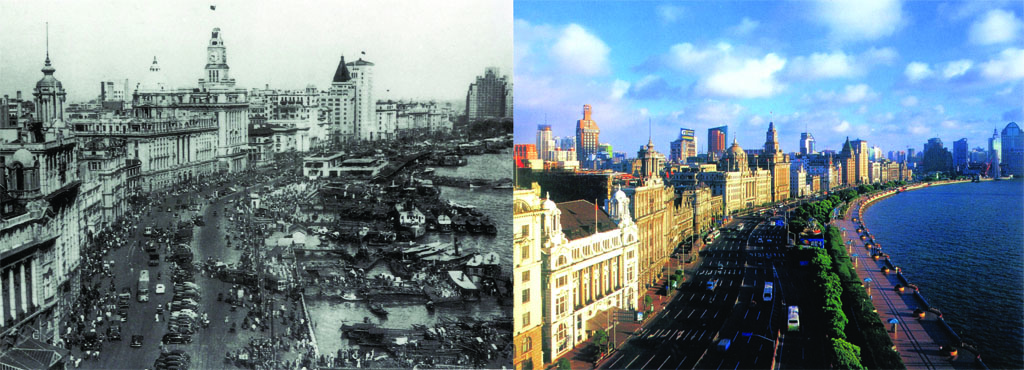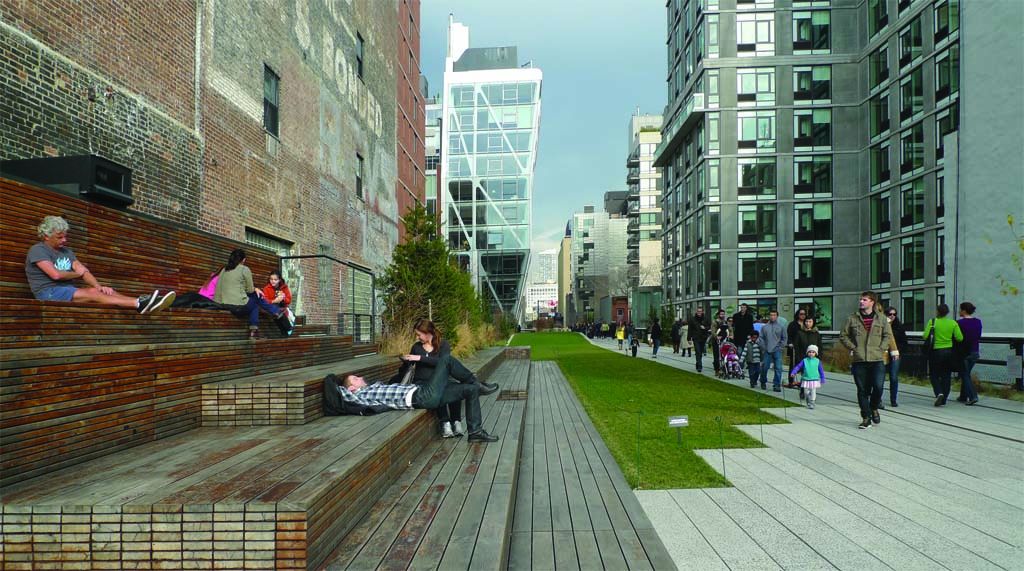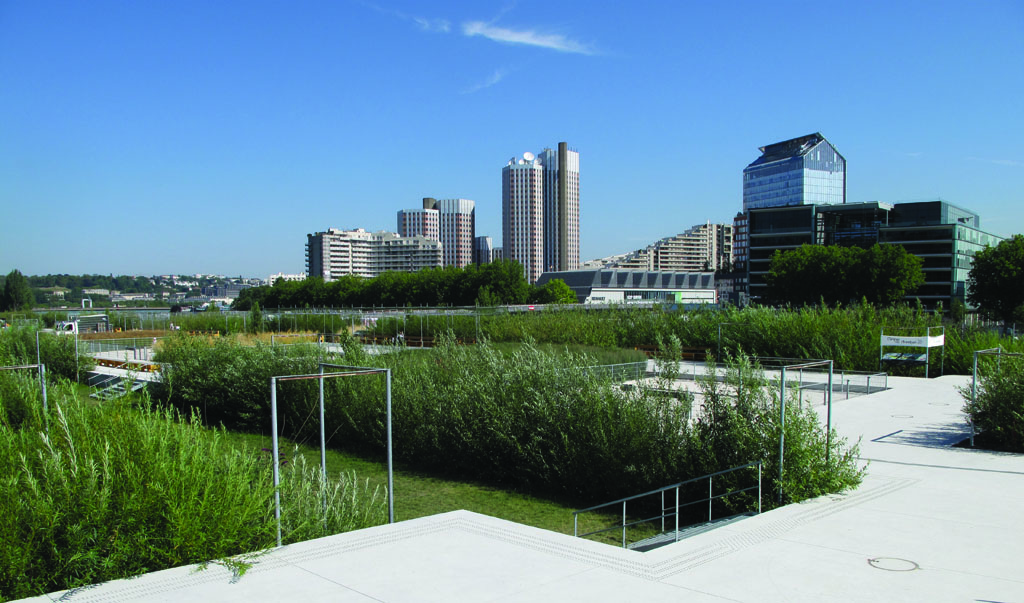The transformation of ports and waterfronts over the last 50 years has produced the most interesting and innovative spaces in big cities.
Shanghai’s Bund, the old mooring place and loading wharf, has become the most emblematic civic space in the metropolis, going from a peripheral relation with the river Huanpu to a waterside promenade that communicates spectacularly with the commercial hub of Pudong.
Manhattan’s waterfront on the Hudson is its most buoyant real-estate sector, and the High Line recycles an old railway line beside the port as a raised greenway of exclusive design.
Paris is rehabilitating the former Renault site on Île Seguin in the Seine with the aim of creating new downtowns away from the traditional city centre.
These are some examples of how new ideas have developed in obsolete spaces that used to have other functions and were never conceived as multifunctional spaces with important civic and symbolic values. It is as though recycling obsolete spaces were a necessary condition for innovation.
Urban design is incorporated to rescale these spaces and give them the scope and quality they need to implant mixed urban uses. Instead of ideal models of abstract city, the aim seems to be singular spaces for the individual city, where the combination of old and new induces fresh creativity.
Meanwhile, ports continue to seek new locations with deeper waters on sites that are more accessible to rail and heavy transport. Their new functionality has very precise demands that are evolving at high speed due to changes in shipping and unloading techniques. But logistics, too, are changing fast, calling for constant adjustments to port facilities. The design of these huge sites needs evolving, adaptable forms rather than rigid, monofunctional patterns. Only then can it anticipate transformation, which, in view of recent experiences, will be faster and faster.
Puerto Madero in Buenos Aires is an excellent example. Its system of wharfs was practically unusable, becoming obsolete almost immediately after its construction; its success lay in its urban transformation as a singular part of the capital city.
An evaluation of the transformations made to ports shows that access to the water has become the foremost civic and popular attraction in different urban cultures, and this is probably a point of no return. Urbanistic culture is presenting new demands that seek to re-establish relations between the natural and the urban world, along with improved use of resources; and water, taking into account its complete cycle, plays a fundamental role.
It is in this way that design at the different scales can contribute to the recycling of abandoned spaces, as well as introducing new logics into actions and projects with an approach that takes into account “two-cycle” design. This involves addressing the programme in hand but also considering long-term evolution, seeking to interpret situations that may be unknown but which can be simulated. It is in this way that urban forms and adaptable projects emerge as thought-provoking ways of working for the future.
 Past and present of Shanghai’s Bund. From the old mooring place and loading wharf to the most emblematic civic space in the metropolis as a waterside promenade that communicates spectacularly with the commercial hub of Pudong.
Past and present of Shanghai’s Bund. From the old mooring place and loading wharf to the most emblematic civic space in the metropolis as a waterside promenade that communicates spectacularly with the commercial hub of Pudong.
 High Line recycles an old railway line as a raised greenway of exclusive design along Manhattan’s west waterfront in the most buoyant real-state sector.
High Line recycles an old railway line as a raised greenway of exclusive design along Manhattan’s west waterfront in the most buoyant real-state sector.
 Île Seguin in the Seine creates new downtowns and civic spaces away from the traditional Paris city centre.
Head image: Puerto Madero, Buenos Aires.
Île Seguin in the Seine creates new downtowns and civic spaces away from the traditional Paris city centre.
Head image: Puerto Madero, Buenos Aires.
Viejos puertos, nuevas ideas: el diseño en doble ciclo
La transformación de los puertos y frentes de agua en los últimos cincuenta años ha producido los espacios mas interesantes e innovadores en la grandes ciudades.
Shanghai y el Bund, antiguo lugar de atraque de los buques y descarga de mercancías, se ha convertido en el espacio cívico más emblemático de aquella metrópolis y ha pasado de un trasiego perpendicular al Huanpu river a un espacio de promenade y de espectacular relación con su centro en Pudong.
Manhattan dispone en su fachada al Hudson del sector inmobiliario más boyante y el High-Line recicla un antiguo trazado ferroviario junto al puerto como paseo peatonal elevado de exclusiva factura.
Paris rehabilita los terrenos de la Renault en Île Seguin en el Sena buscando crear los espacios de nueva centralidad fuera del centro tradicional.
Son algunos de los ejemplos de cómo las nuevas ideas se han desarrollado en espacios obsoletos que tenían otras funciones y que nunca habían sido pensados como espacios multifuncionales y de alto valor cívico y simbólico. Parece como si el reciclaje de espacios obsoletos fuerala condición necesaria para la innovación.
El diseño urbano se incorpora para re-escalar estos espacios y darles la dimensión y calidad necesarias para implantar los usos mixtos urbanos. En lugar de modelos ideales de ciudad abstracta, parecen buscarse espacios únicos y singulares para cada ciudad donde el gusto por combinar lo antiguo y lo nuevo induce a una nueva creatividad.
Por otro lado los puertos siguen buscando nuevos emplazamientos en aguas más profundas y en suelos más accesible para el ferrocarril y los transportes pesados. Su nueva funcionalidad tiene unas exigencias muy precisas que evolucionan a gran velocidad debido a los cambios en las naves y técnicas de descarga. Pero también la logística en sí misma está cambiando a ritmos forzados, y obliga a ajustar constantemente las plantas portuarias. El diseño de estas grandes emplazamientos quizás debería contar mas con formas evolutivas y adaptables que con patrones formales rígidos y monofuncionales. Sólo así se puede anticipar la transformación que a la vista de las recientes experiencias llegará cada vez más rápido. Recordemos el excelente ejemplo de Puerto Madero en Buenos Aires, cuyo sistema de muelles prácticamente no llego a poder utilizarse por quedar obsoleto inmediatamente después de su ejecución y el éxito ha habido que buscarlo en su transformación urbana como pieza singular en aquella ciudad capital.
Si nos atreviéramos a juzgar la transformación operada en el conjunto de puertos, diríamos que el acceso al agua se ha convertido en la máxima atracción cívica y popular en las distintas culturas urbanas, y es probablemente un punto de no-retorno. Ahora nos aparecen en la cultura urbanística nuevas demandas que buscan restablecer la relación entre el mundo natural y el urbano, así como el mejor uso de los recursos; y el agua – si se tiene en cuenta su ciclo completo – es una parte fundamental.
Ahí es donde el diseño en sus diferentes escalas puede aportar una capacidad en el reciclaje de espacios abandonados, pero también introduciendo nuevas lógicas en las acciones y proyectos desde una actitud que tiene en cuenta el diseño en “doble ciclo”, es decir que da respuesta al programa del momento, pero también atiende a la evolución en el largo plazo, buscando interpretar situaciones desconocidas pero que en gran medida podemos simular. Ahí es donde las formas urbanas y proyectos “adaptables” se nos presentan como una pauta de trabajo llena de riqueza y porvenir.Past and present of Shanghai’s Bund. From the old mooring place and loading wharf to the most emblematic civic space in the metropolis as a waterside promenade that communicates spectacularly with the commercial hub of Pudong. High Line recycles an old railway line as a raised greenway of exclusive design along Manhattan’s west waterfront in the most buoyant real-state sector. Île Seguin in the Seine creates new downtowns and civic spaces away from the traditional Paris city centre. Head image: Puerto Madero, Buenos Aires.